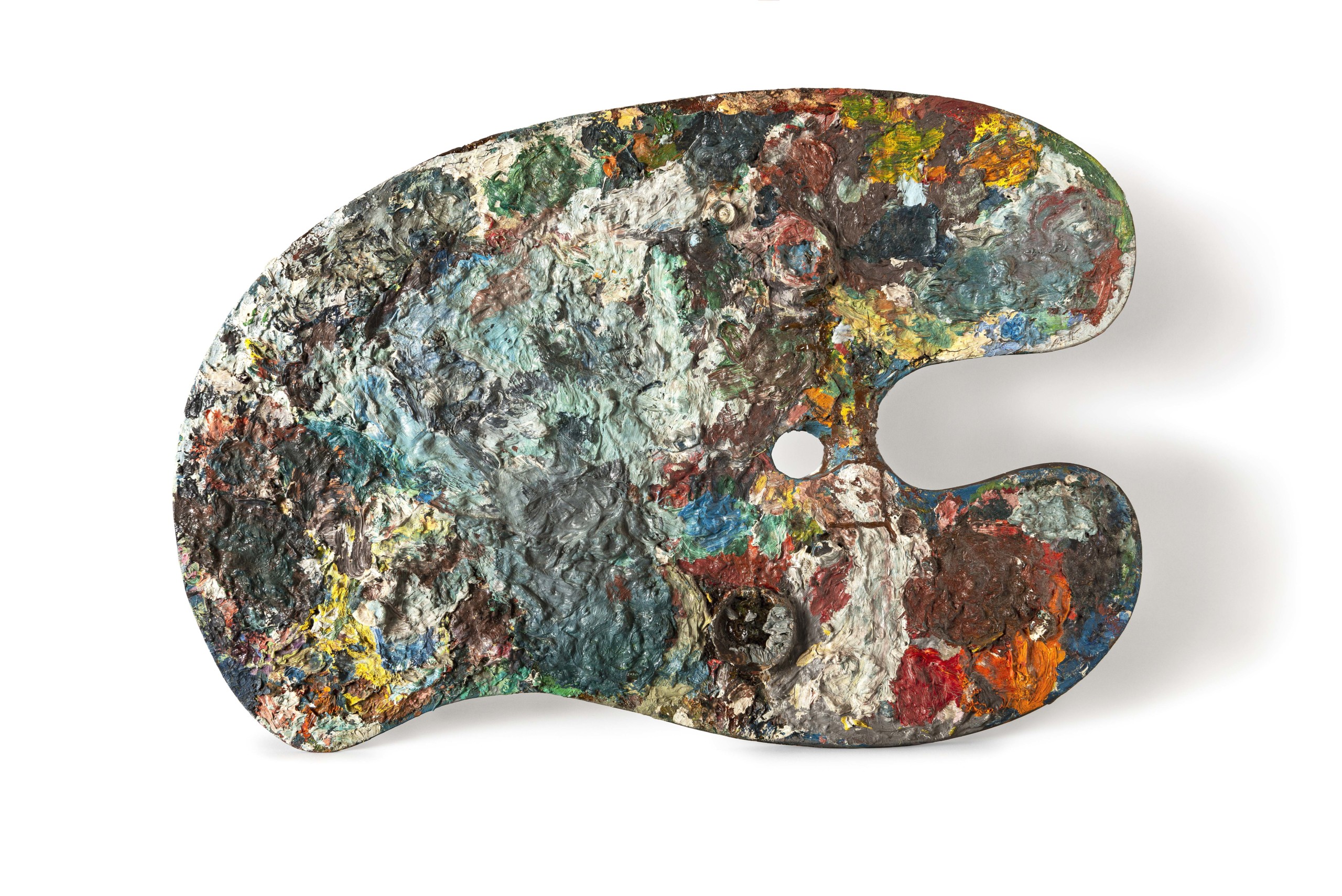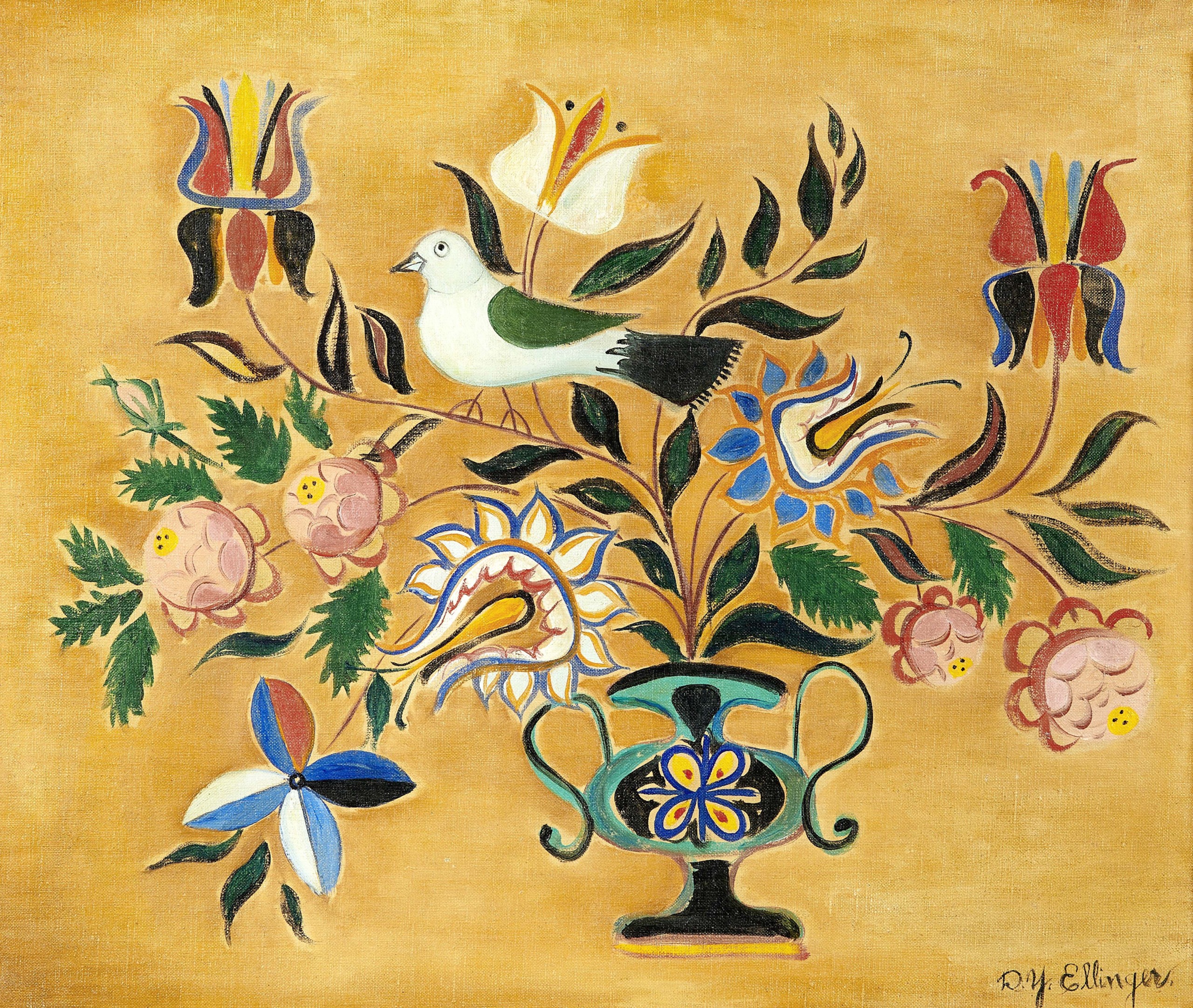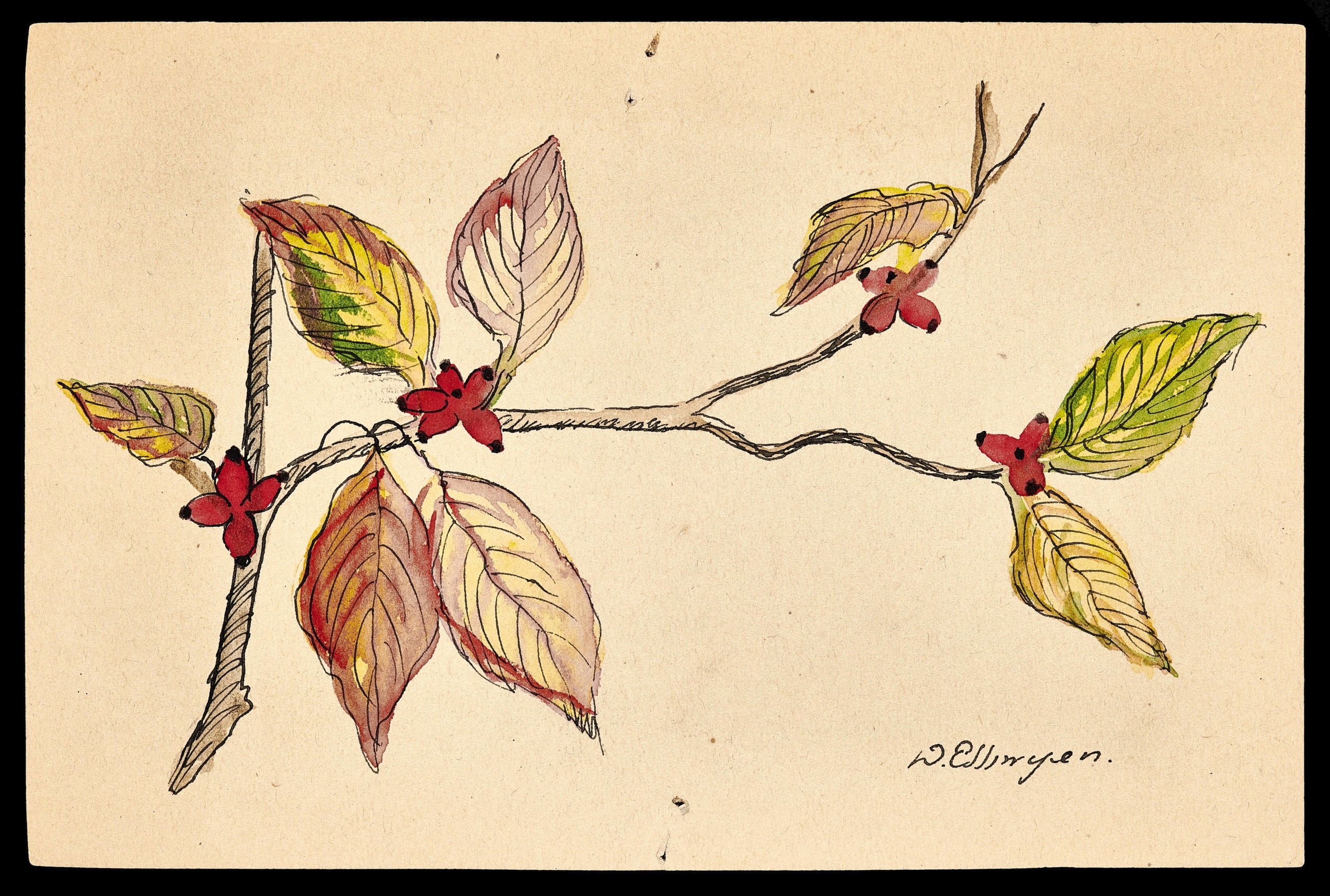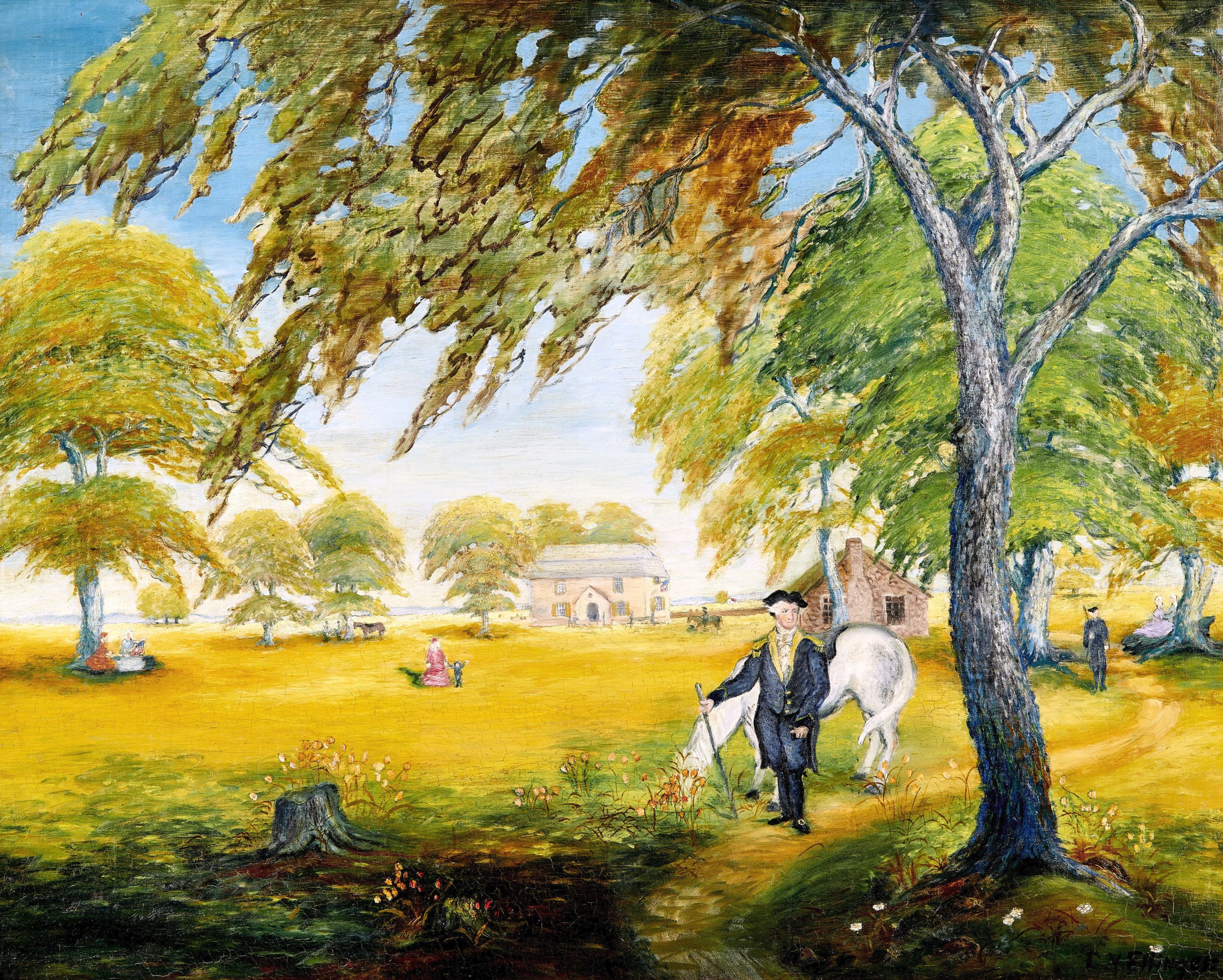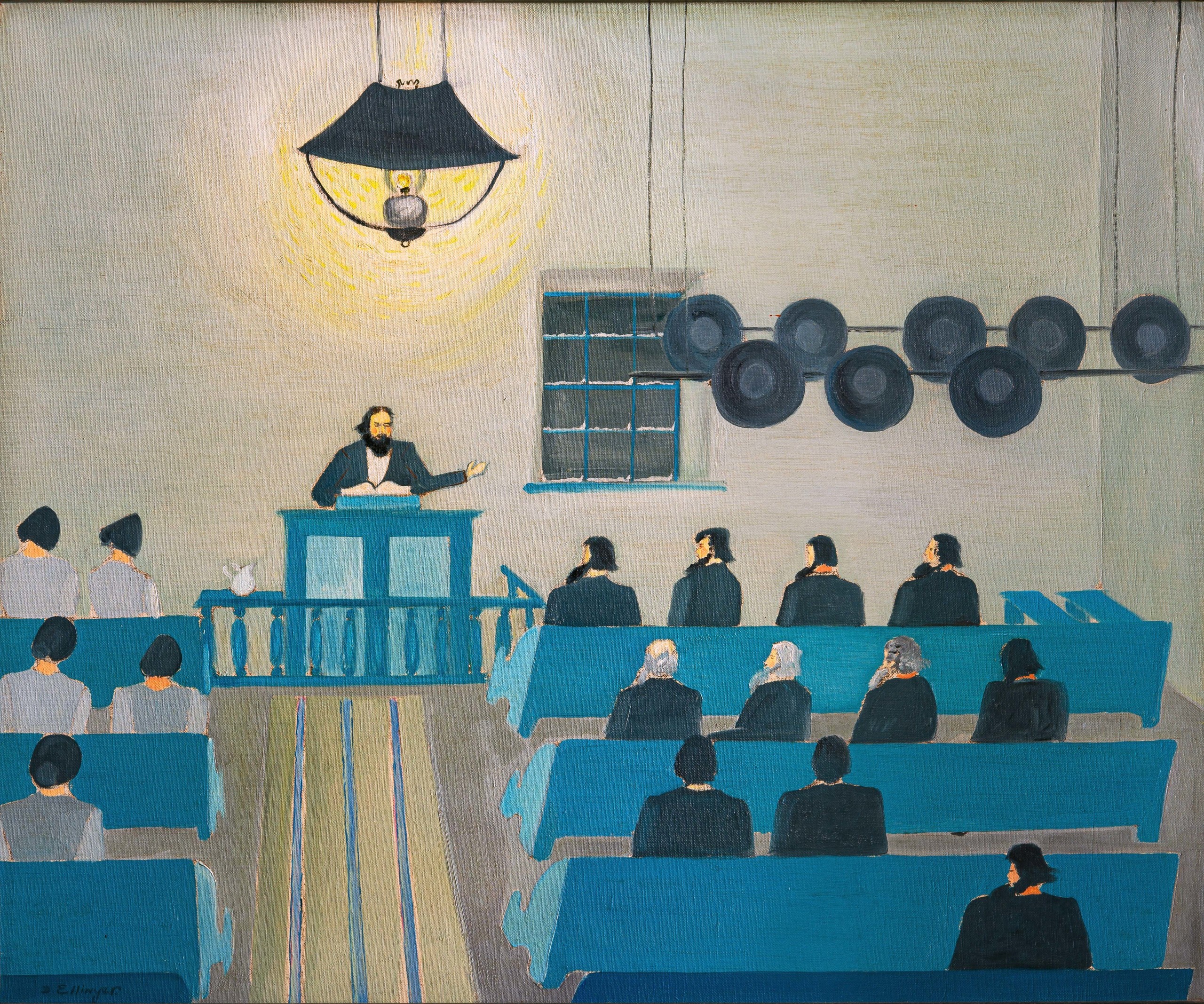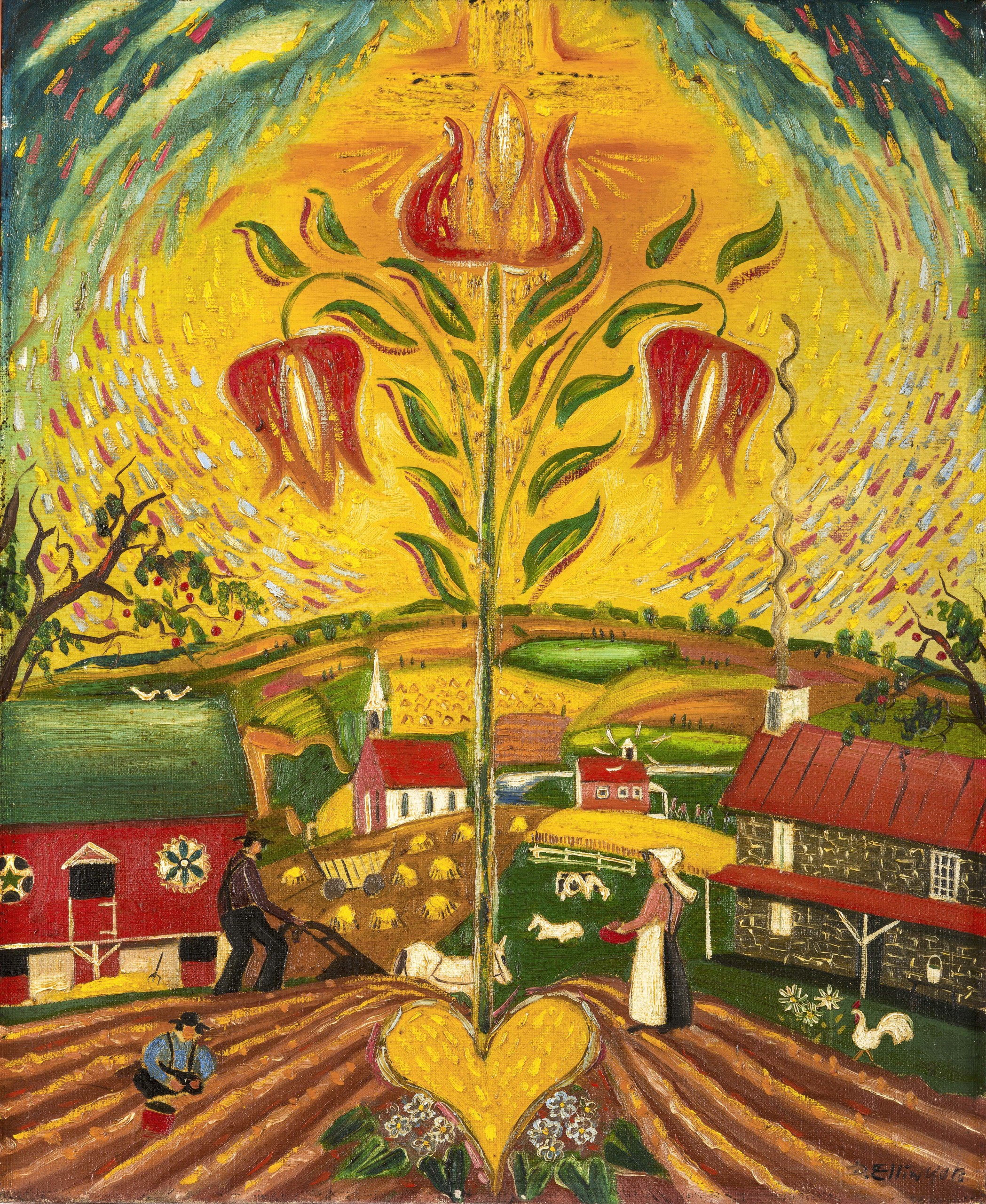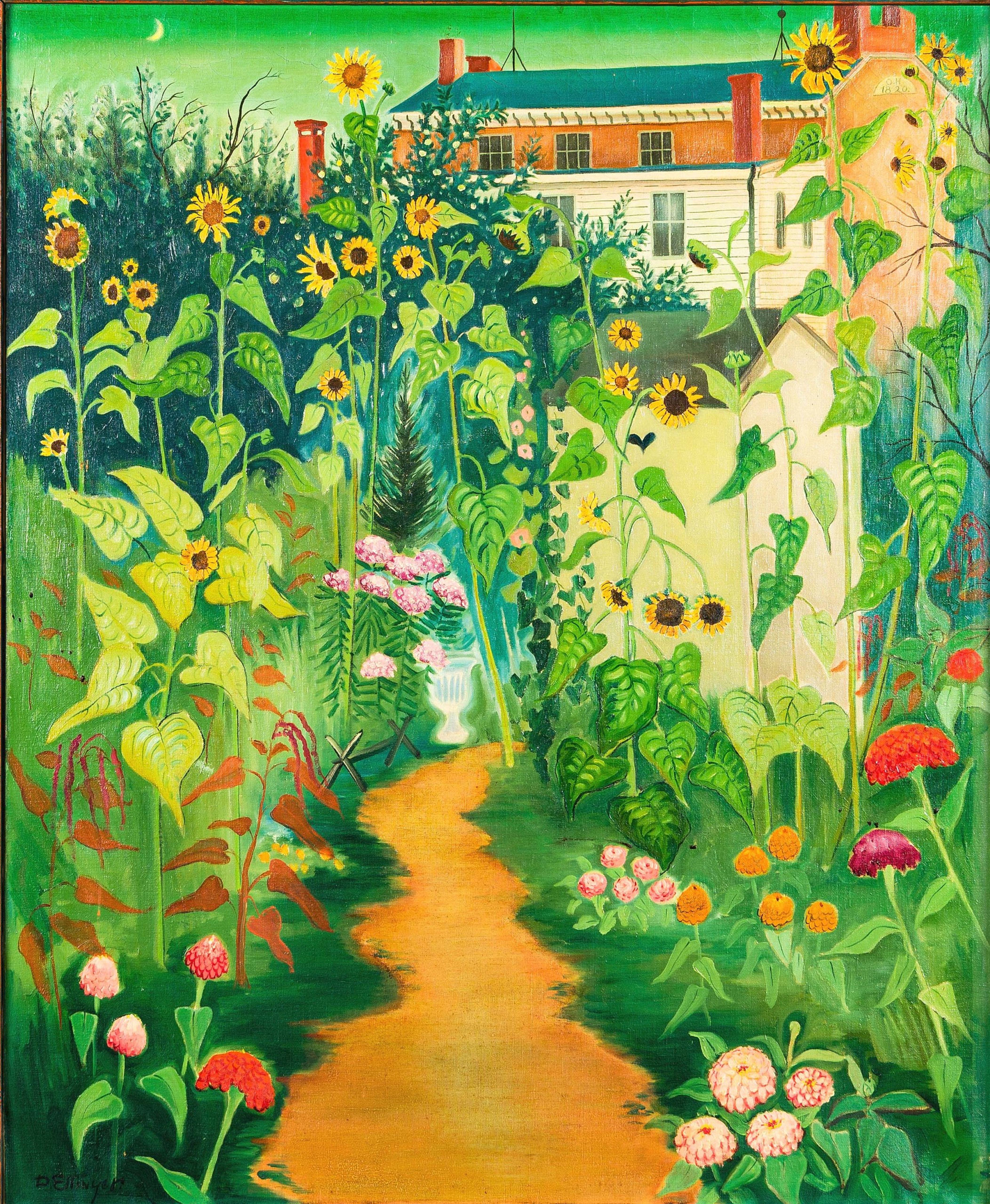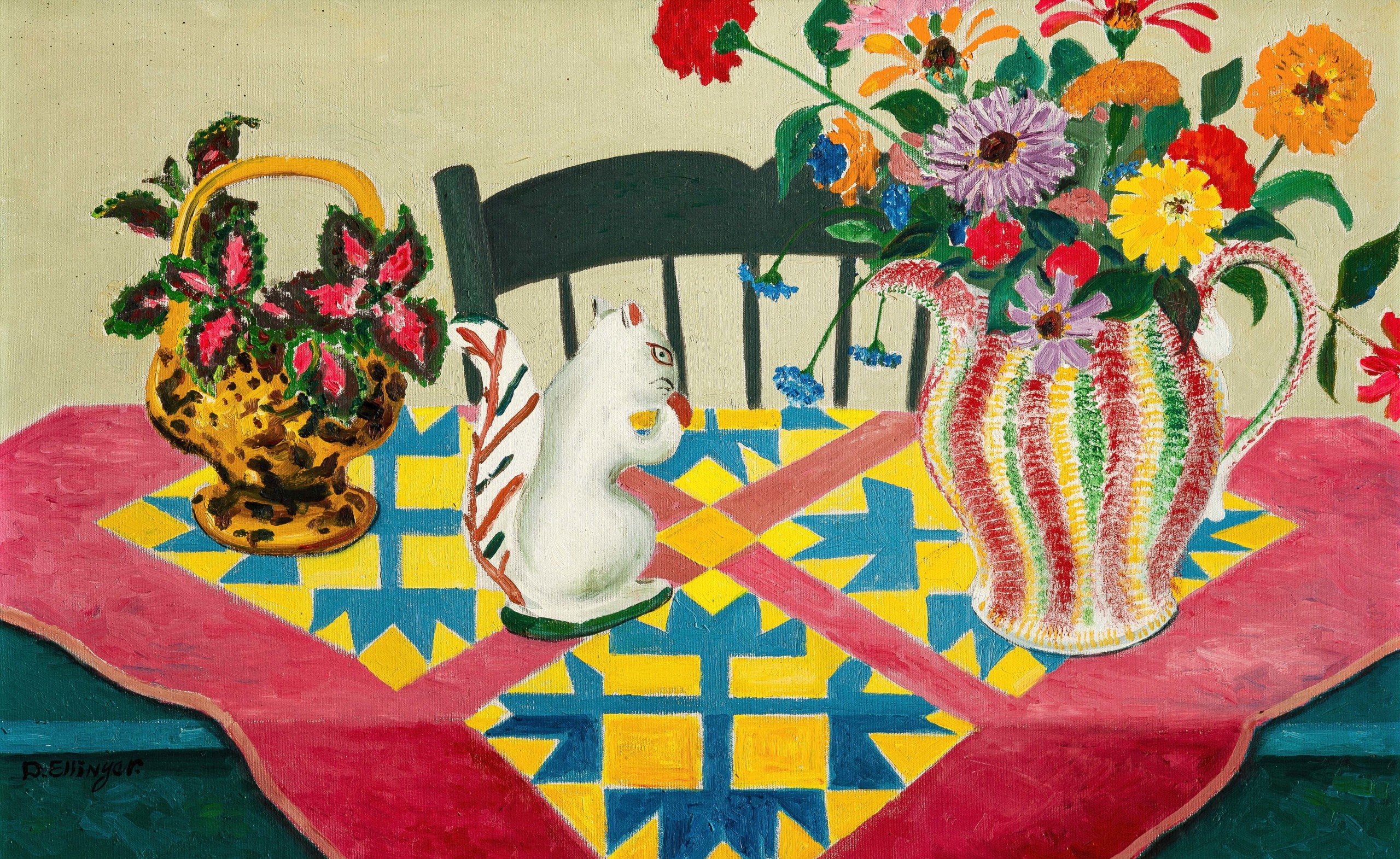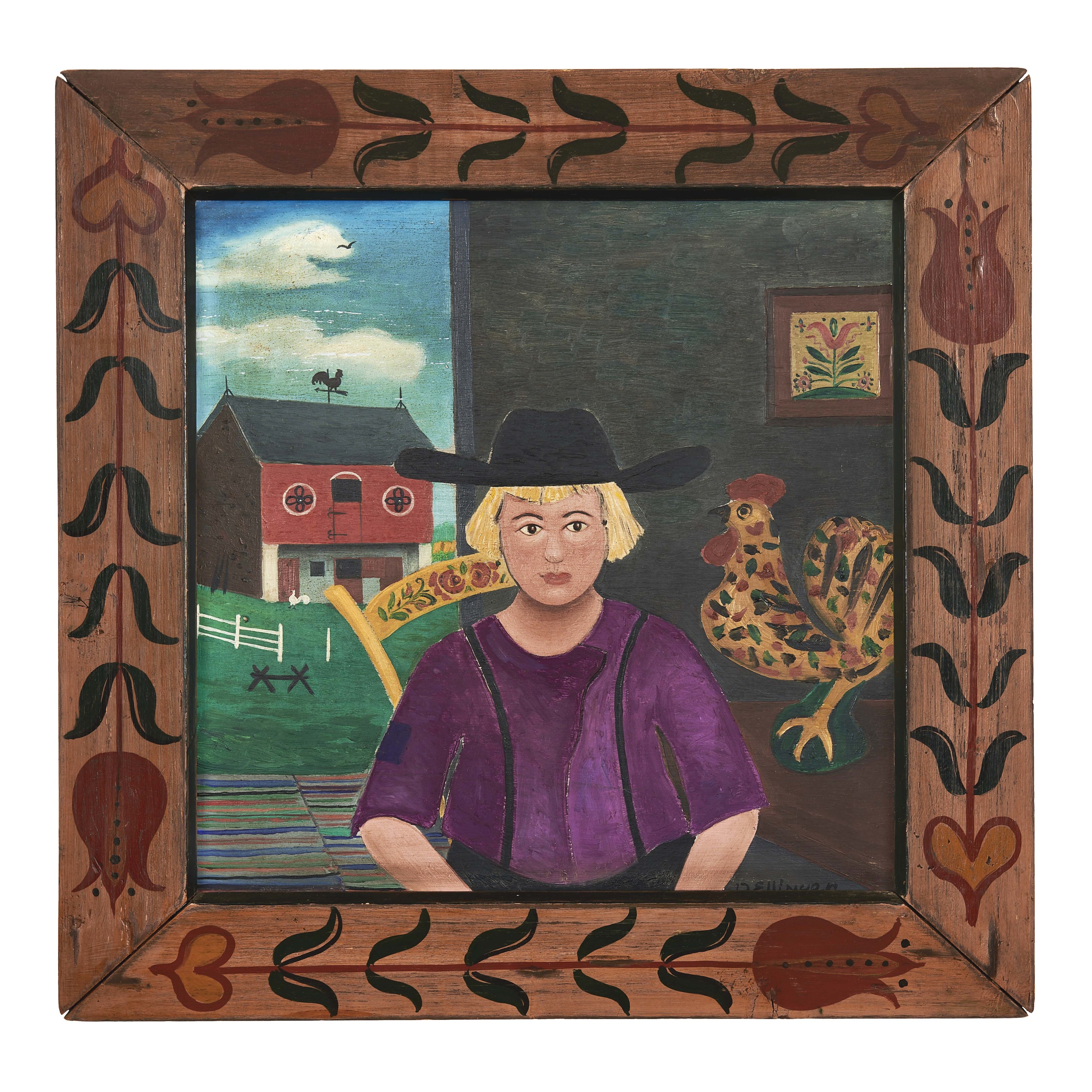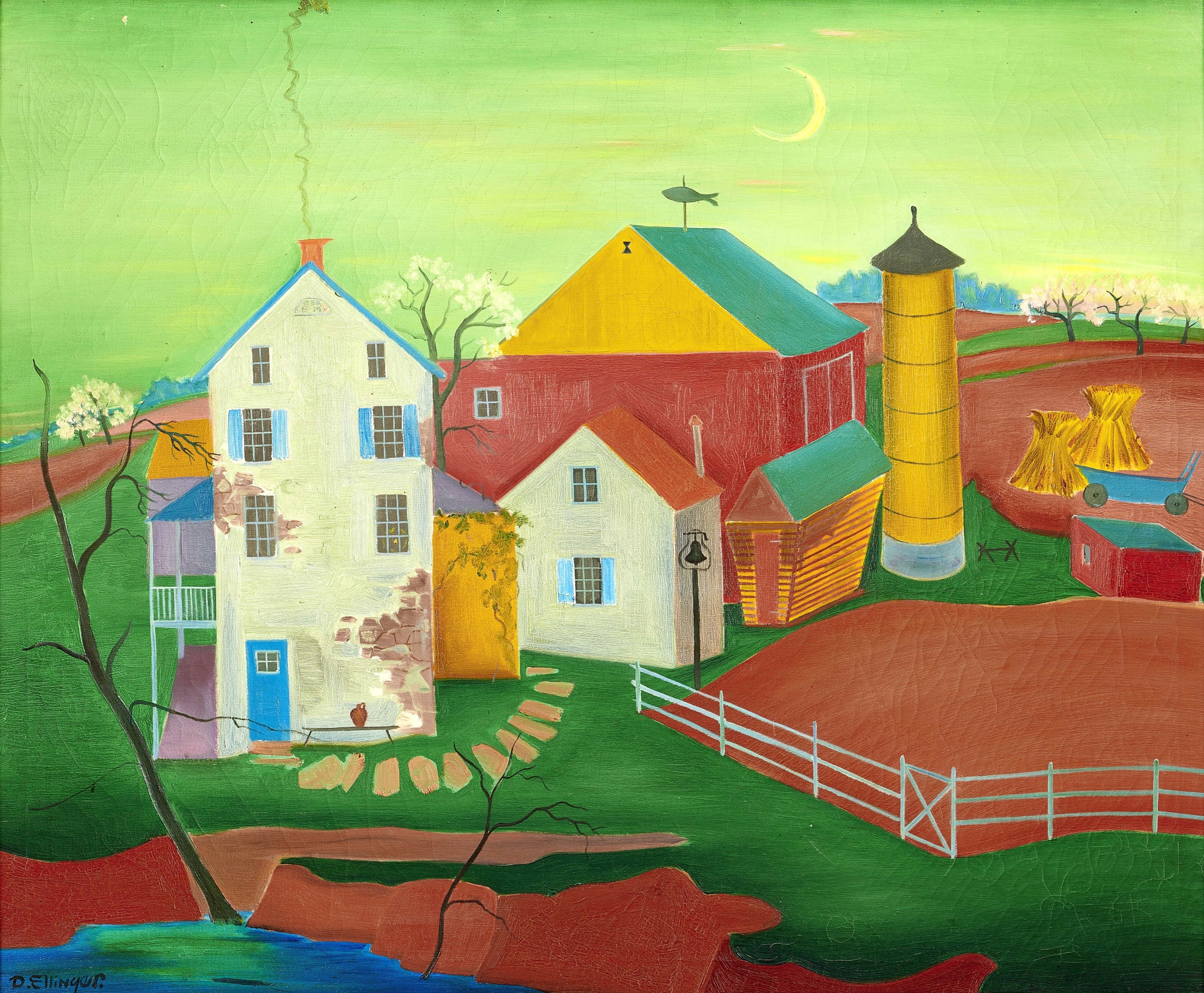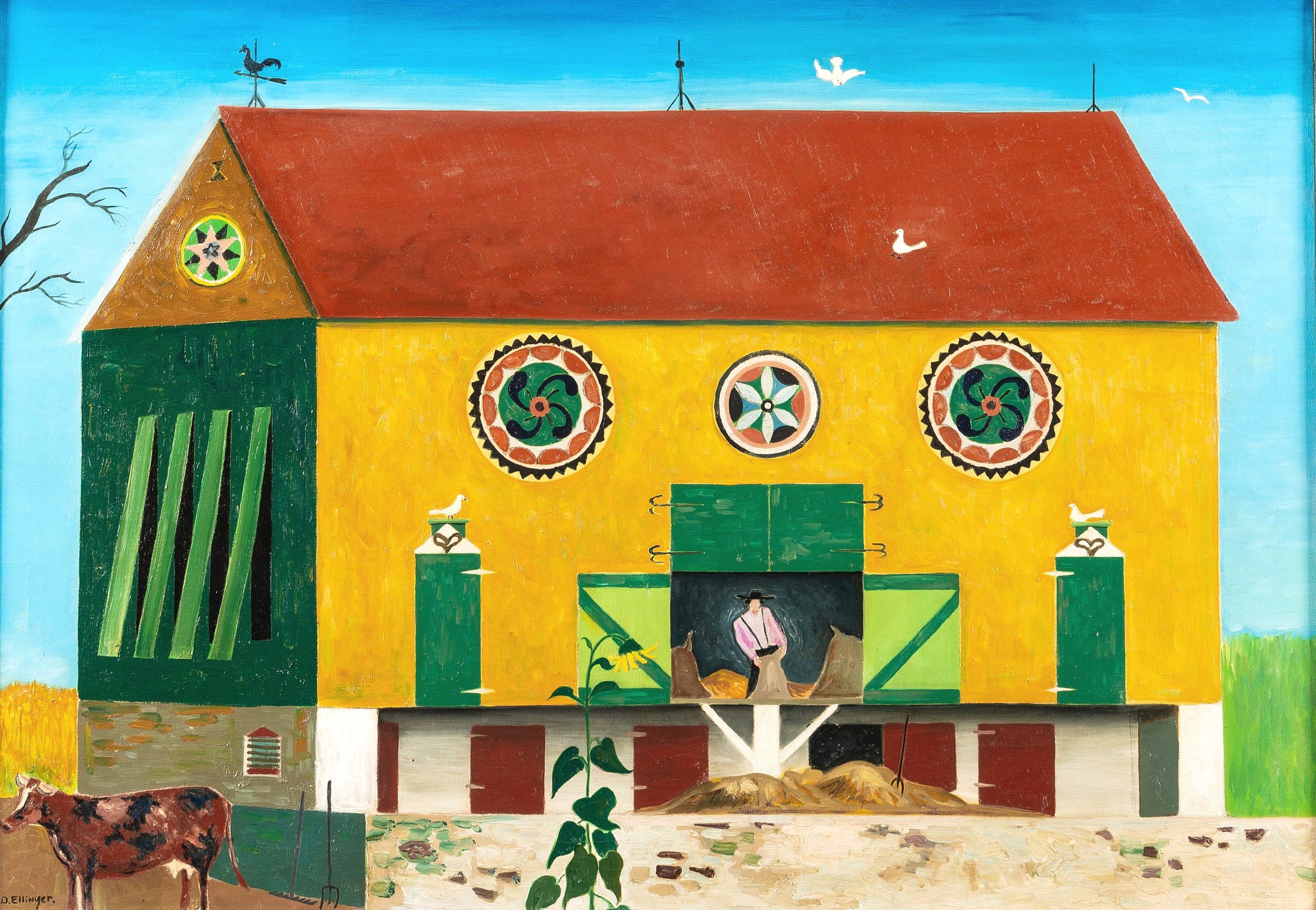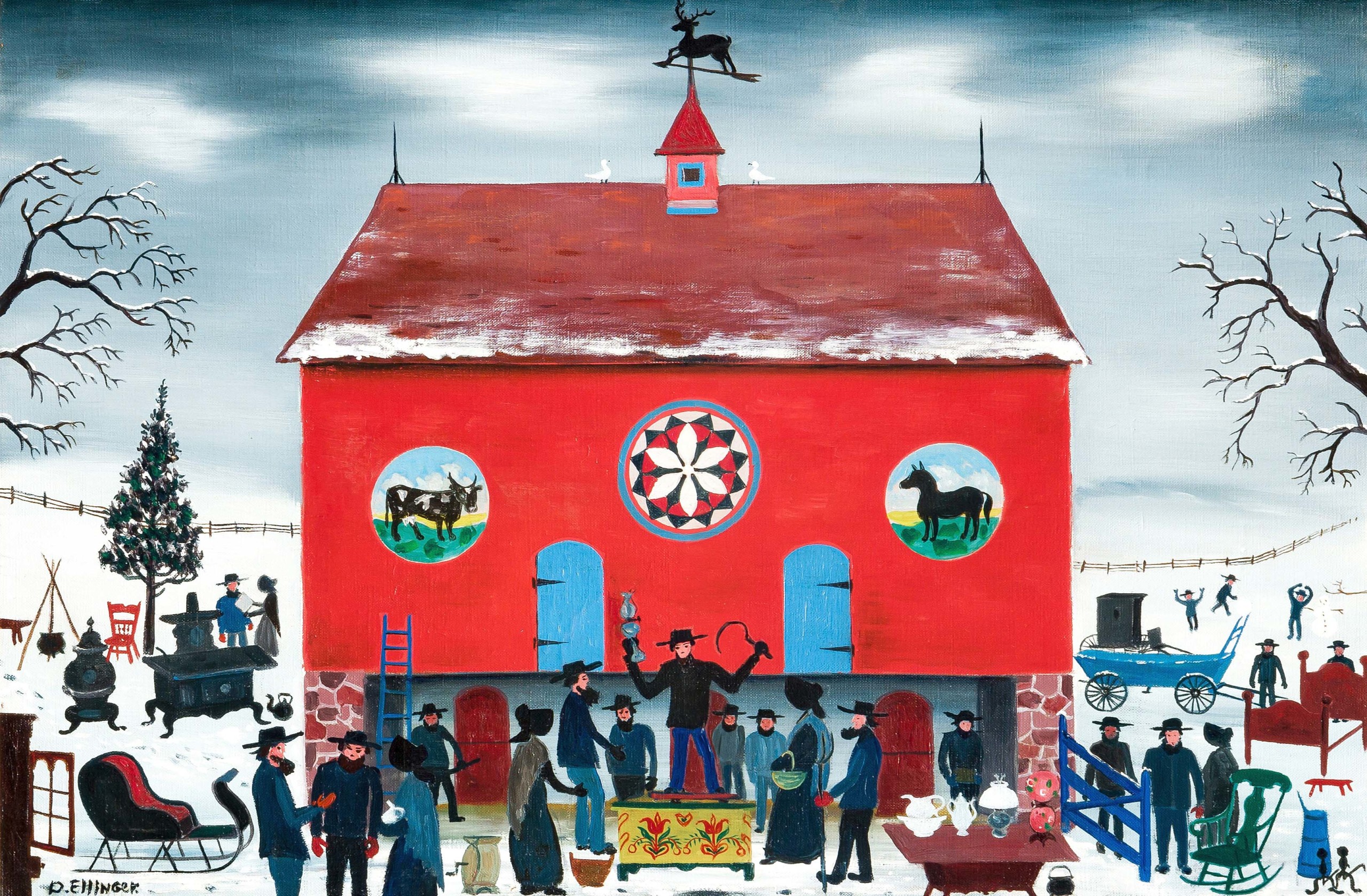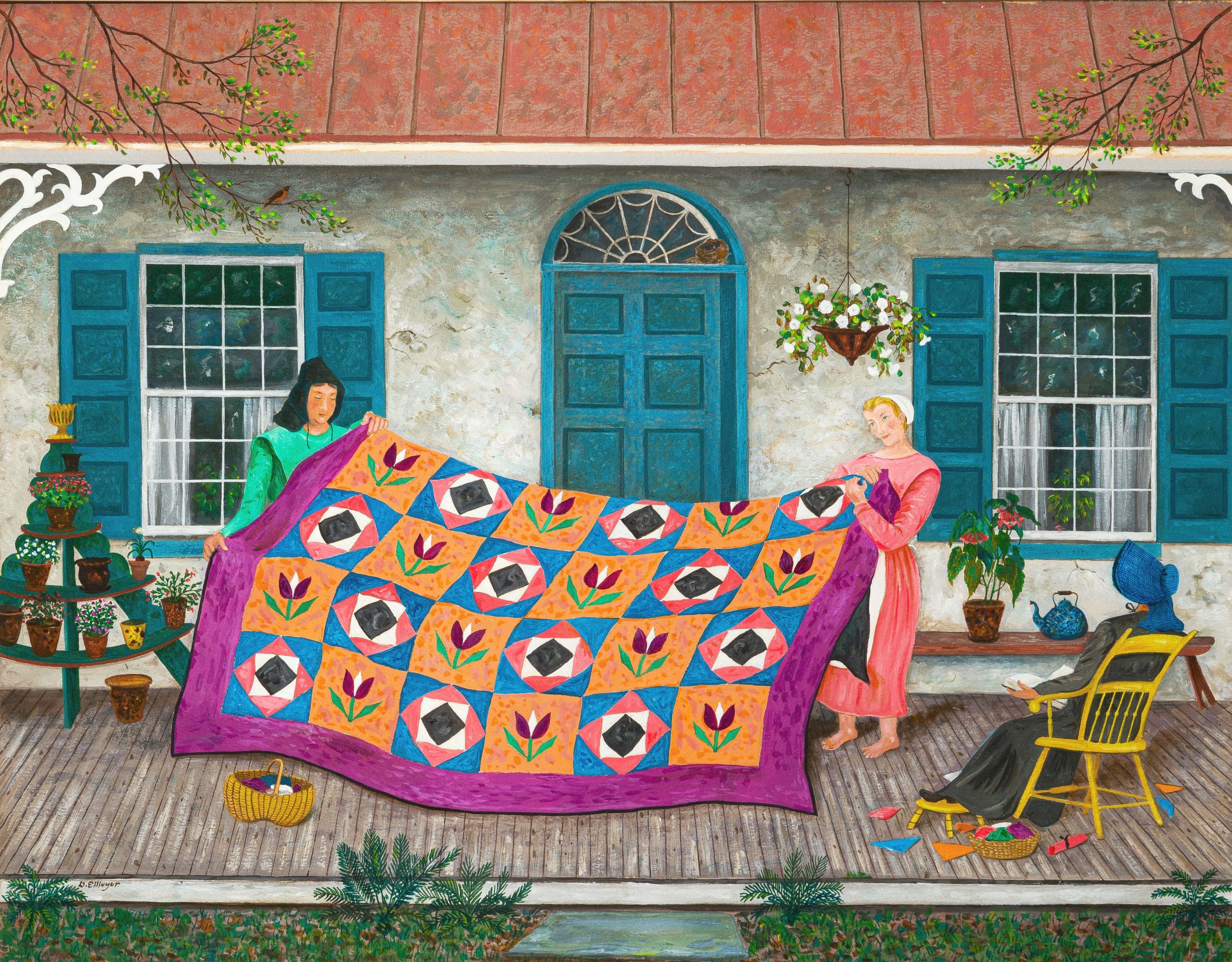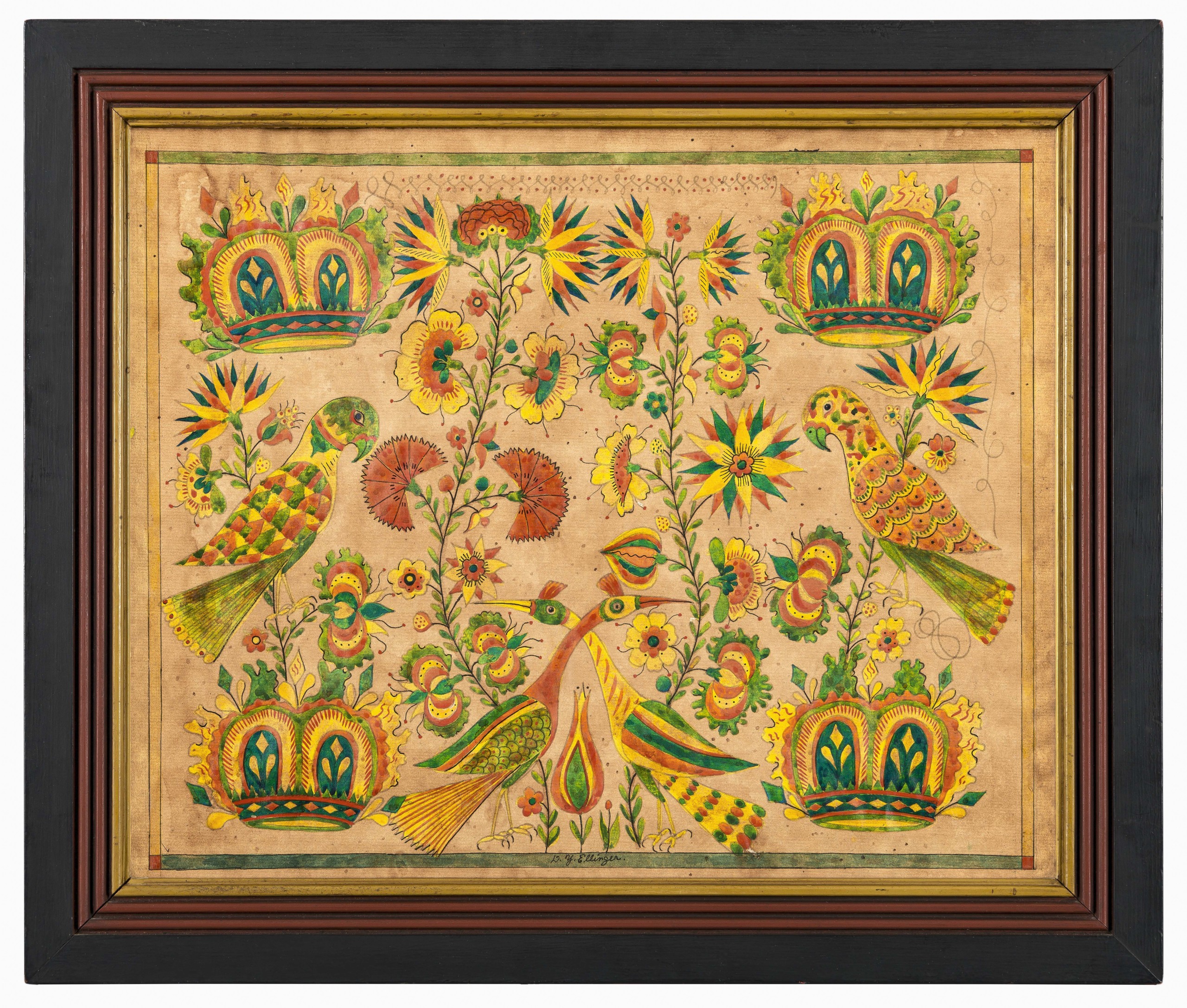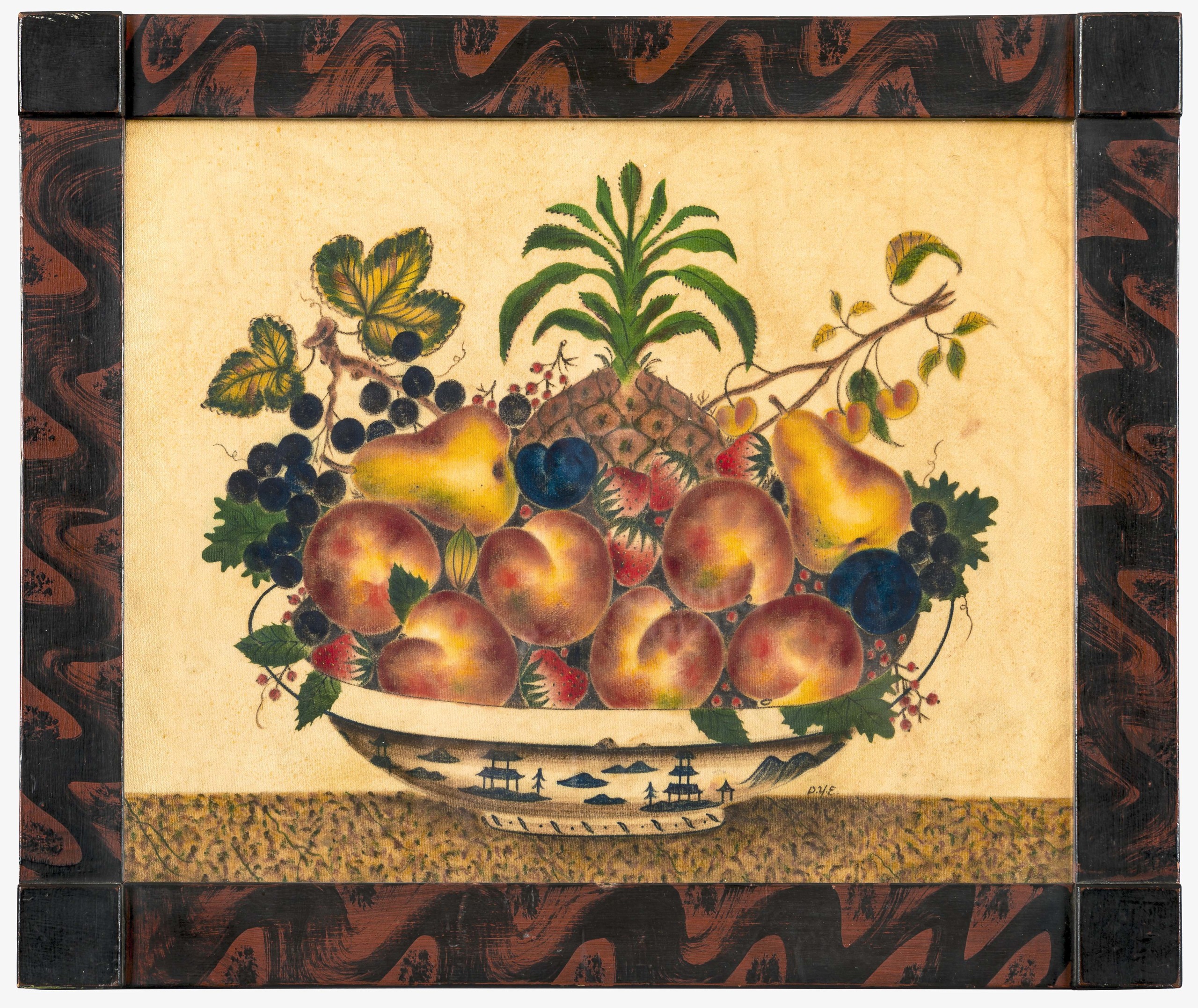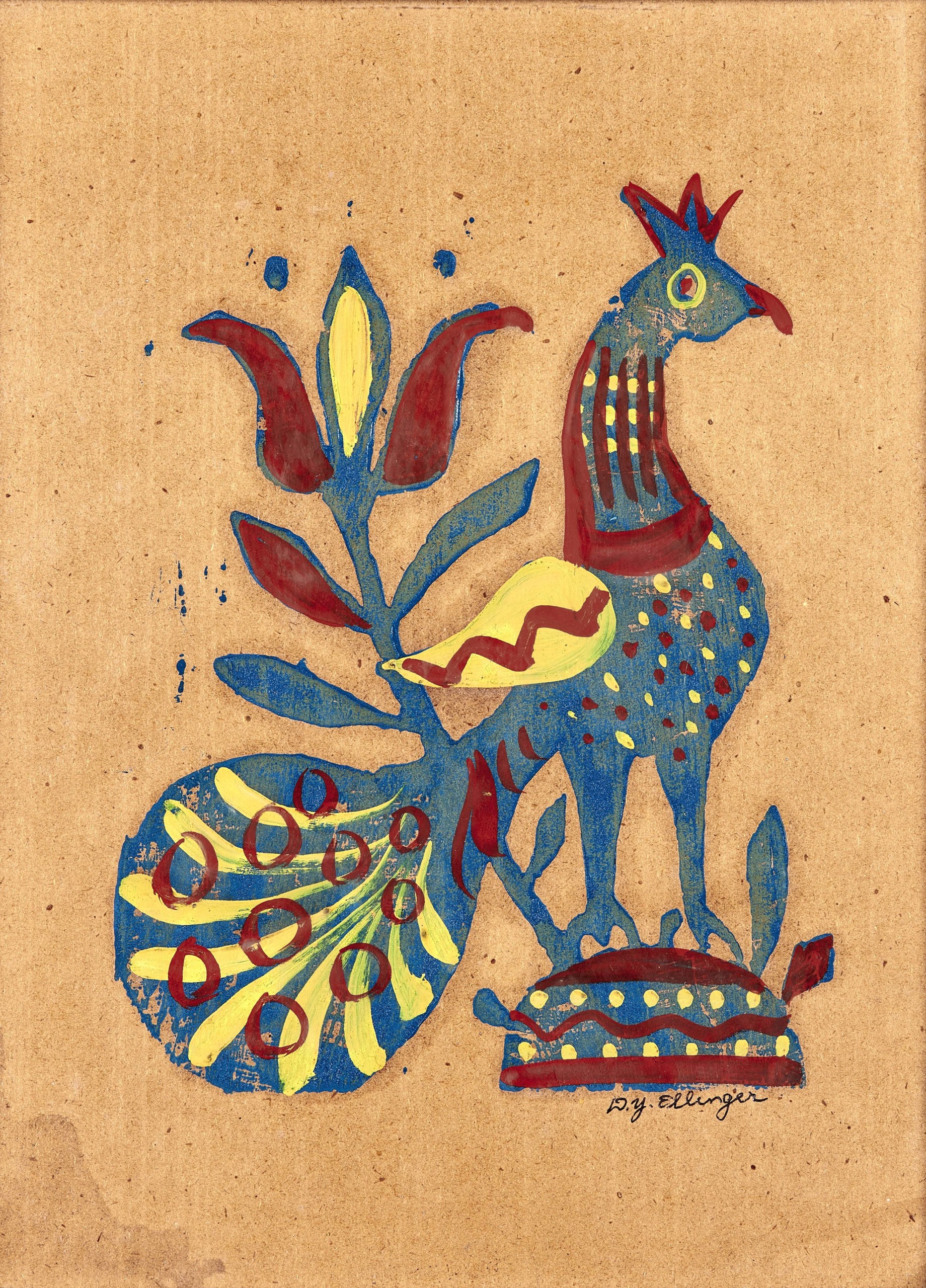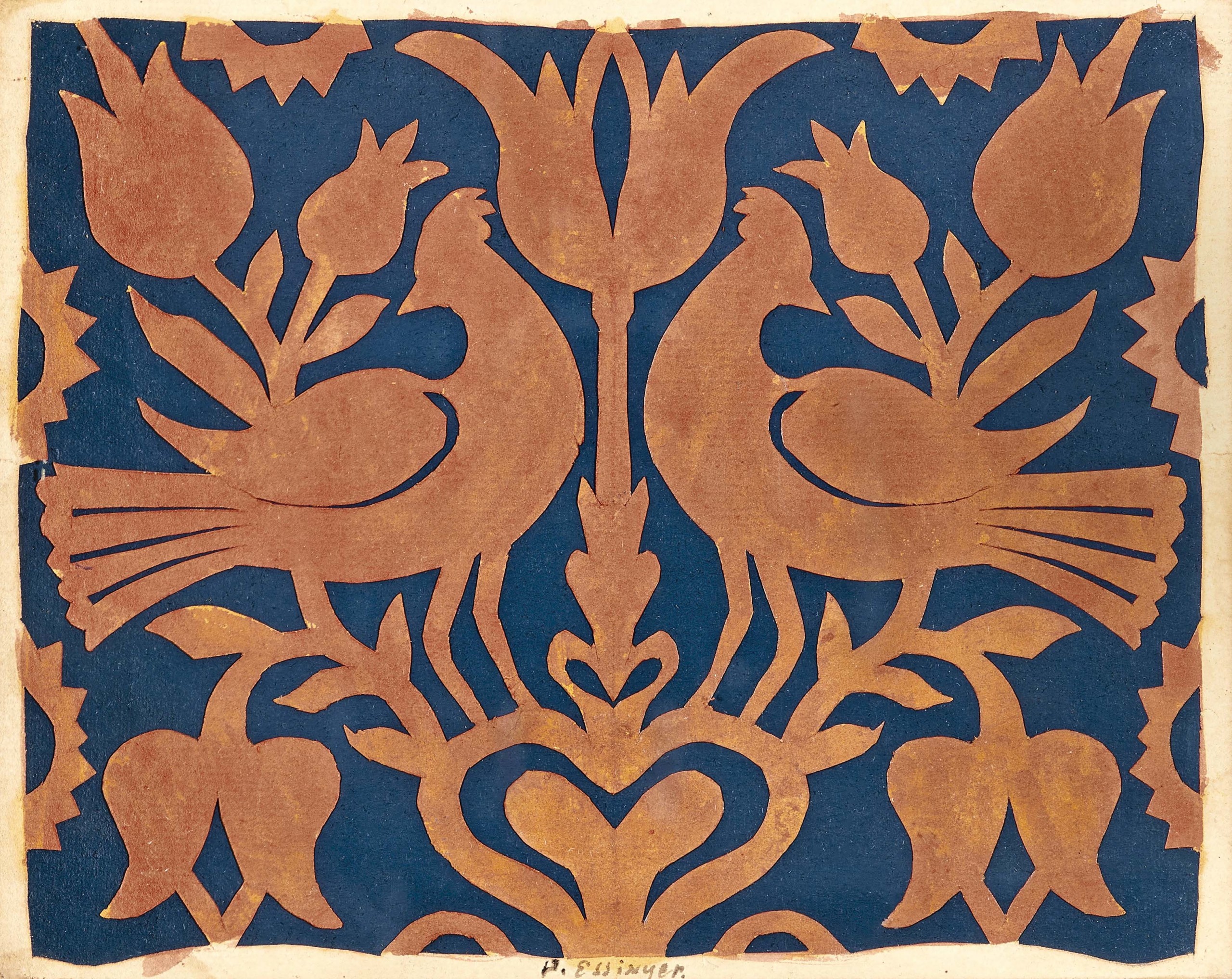
Among Ellinger’s earliest cutworks is this untitled and undated example, watercolor on paper, 6 by 7 1/2 inches. Collection of Richard Allen.
By Madelia Hickman Ring
TRAPPE, PENN. — Historic Trappe’s newest exhibition, which opened on September 30 and will be on view through July 28, is “Native Son: The Life & Art of David Ellinger.” The exhibition is a major retrospective of the work of David Ellinger (1913-2003), a local folk artist of national renown, who spent much of his life living and working within Trappe. It brings together more than 100 of Ellinger’s works, from Historic Trappe’s own collection but also loans from Ellinger’s family and private collectors as well. On view will be not only Ellinger’s quintessential paintings of midcentury life in rural Pennsylvania but botanical drawings, still life paintings, theorems and fraktur drawings. The exhibition is curated by Lisa Minardi, executive director of Historic Trappe and a prominent scholar of Pennsylvania German folk art. She was also the guest curator of “Out Of The Heart: The Life And Art Of David Ellinger,” a smaller exhibition of about 60 works which was at Arcadia University from February 3 to April 17, 2022.
“Ellinger has been on my radar as a Trappe artist for a while,” said Minardi, when Antiques and The Arts Weekly asked why the exhibition was particularly relevant at this moment. “When I got involved with Historic Trappe, I became aware we had some small landscapes, done in an early impressionistic style. It made me want to claim him for our town. That’s why we’re calling the exhibition, ‘Native Son.’”
She continued, “I wanted to introduce, or reintroduce, him to the broader folk art, Americana and Pennsylvania German fields, and to show that the Eighteenth and Nineteenth Century Pennsylvania German folk art tradition continues into the Twentieth Century. Ellinger was part of a moment when a lot of that was happening. I want visitors to see the range and breadth of his work, to get a taste of Pennsylvania German art in the Twentieth Century and to understand that it’s still very much a living culture.”

Photograph of David Ellinger, circa 1945. Private collection.
Ellinger, who was self-taught, was one of about 400 artists hired in 1935 by the Federal Art Project’s (a part of the WPA) Index of American Design, an undertaking that lasted until 1942 and resulted in 18,257 watercolor renderings of American folk and decorative arts objects from the colonial period through 1900. In documenting Pennsylvania German artifacts as well as woodcarvings, textiles and sculptural whirligigs and weathervanes from around the United States, the Index attempted to “sustain a distinctly American visual lineage” and was a source of inspiration for artists. Ellinger not only painted for the project, but he worked closely with Frances Lichten, the State Supervisor for Pennsylvania’s contributions to the Index. In 1946, Lichten authored Folk Art of Rural Pennsylvania; her style was similar to that of Ellinger, and she was highly influential to him.
By the mid 1940s, a series of solo exhibitions in New York and Pennsylvania helped launch Ellinger’s career. His landscapes that depicted Pennsylvania German barns, country auctions, Amish family farms and other bucolic scenes were popular with collectors in the second half of the Twentieth Century who had a growing interest and nostalgia for an agrarian past. His use of the now-familiar Pennsylvania German motifs of hearts, birds and tulips, in vivid colors, tapped into a receptive audience with a growing interest in folk art.
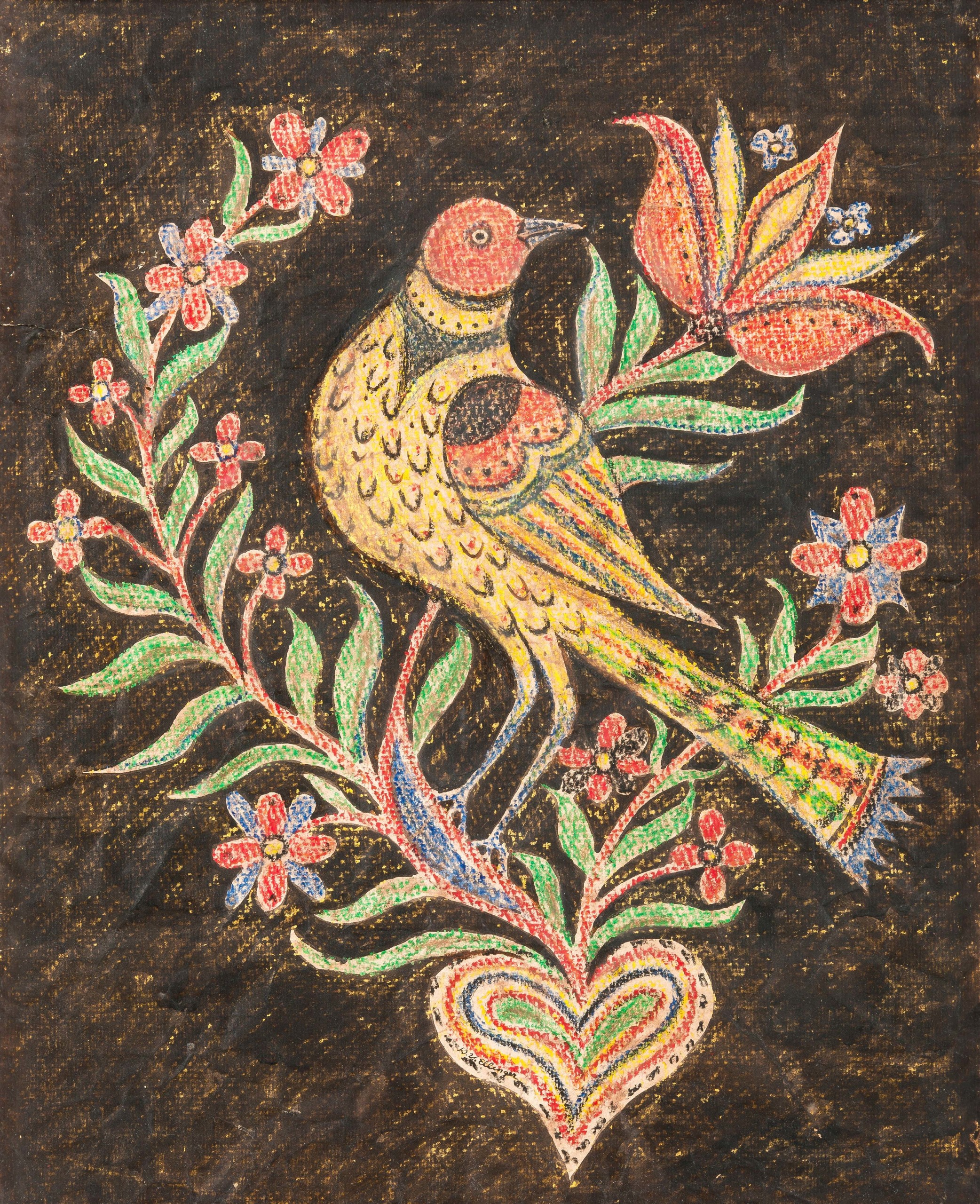
Untitled (drawing of a bird and flowers), crayon on paper, 20-5/8 by 16 3/4 inches. Collection of Dr David Bronstein. Ellinger inscribed the back of this drawing, “One and only / Crayon I ever did.” The image of a bird perched on a heart with a tulip and other flowers is derived from Pennsylvania German fraktur drawings but on a much larger scale. The use of a black background also distinguishes this drawing from Ellinger’s fraktur, which were typically done on either plain or antiqued paper.
Ellinger was prolific; by his own estimation, he painted more than 6,000 pictures, in a full range of media, including oil paintings, watercolors, cutworks, theorem paintings, colored pencil, his only known crayon drawing, woodblock prints and even weathervanes. Given such a broad spectrum of work, what criteria for inclusion did the curator employ?
“I wanted to focus on special paintings that most people have never seen. So many collectors think they know Ellinger’s work, but they really don’t. Also, because we’re Historic Trappe, my interest was in things that are local; specific landscapes, known people.” These would include “River Brethren/Love thy Neighbor,” a 1935 work that depicts the interior of the River Brethren meetinghouse in Graterford, Penn., which was located a mile north of Trappe and where Ellinger’s brother, Paul, attended services as a young man. A dairy farm along the Lodal Creek that Ellinger lived and worked on as a teenager is likely the one depicted in his circa 1965 “Down Loudle Creek Way.” Also included are childhood drawings from when Ellinger was in eighth grade, a series of botanical watercolors painted in 1927 when he was just 14, and one of his first large oil paintings: dated 1931, it depicts George Washington in front of Trappe’s Augustus Lutheran Church and is still owned by the congregation.
A portrait of Amos Lapp, painted circa 1950s, retains its original painted frame with flowering vine decoration. From 1946, his “Clematis” shows a view of Emma Keller’s house on Trappe’s Main Street from 1946, the white clematis making a bold comparison to the red brick of the house.
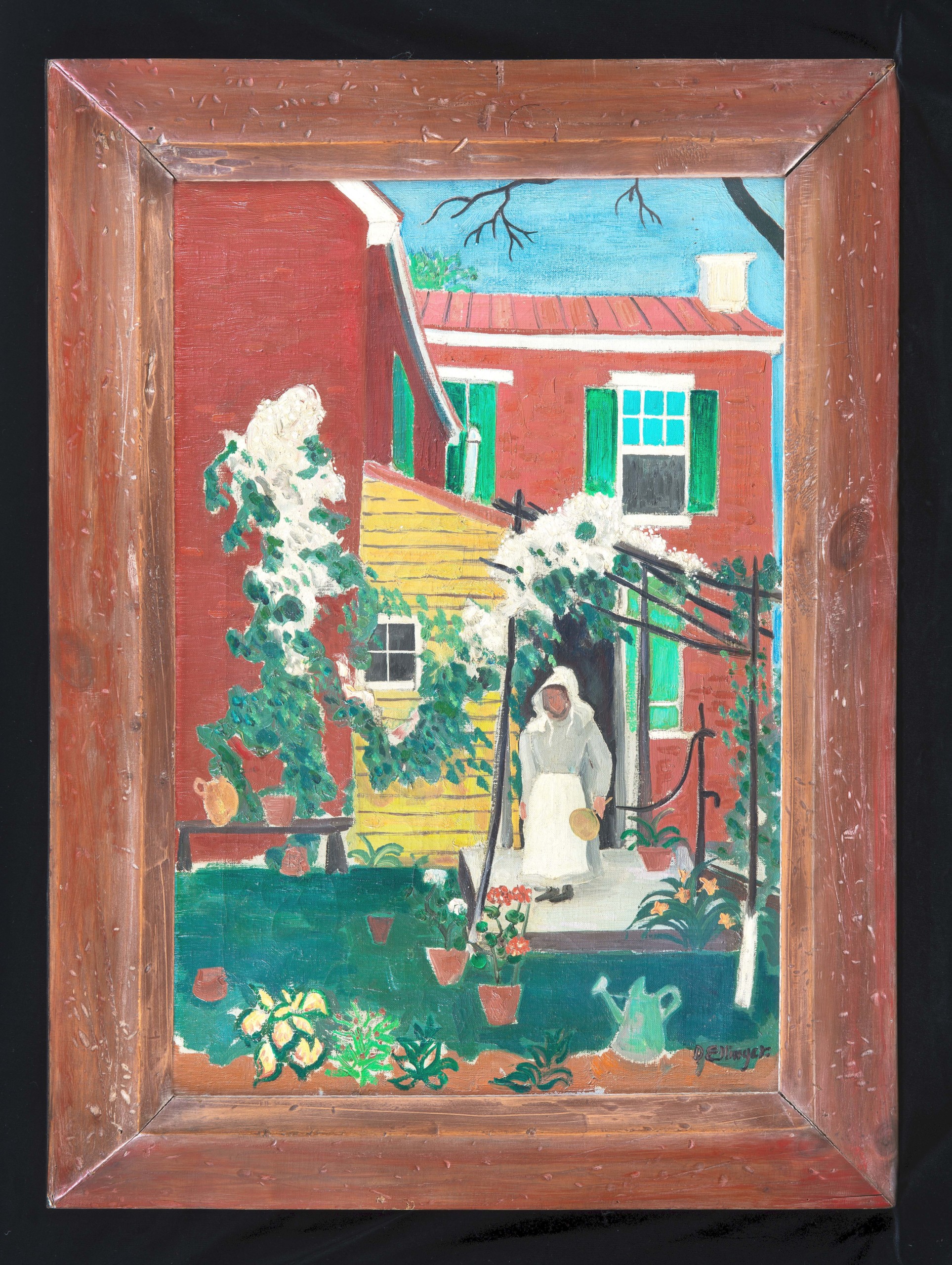
“Clematis,” 1946, oil on canvas, 26 1/2 by 17 1/2 inches. Collection of Dr David Bronstein.
Several featured paintings are noteworthy for other reasons. His most famous painting, “Out of the heart comes the issues of life,” which he painted in 1943, was first exhibited at the Norristown Art League in 1944 and was included in the American-German Review along with an essay about Ellinger’s solo exhibition at the Carl Schurz Memorial Foundation in Philadelphia. “Garden Path” from 1945 is one of the artist’s largest and most detailed paintings. One of his earliest dated paintings to feature Amish subjects is “The Quilt,” from 1943, which he painted when he was 30 and which stands out for its use of realism rather than stylized abstraction.
When he wasn’t painting, Ellinger was also dealing in American and Pennsylvania German antiques, attracting the attention of several collectors, including pioneering ones like Albert Barnes, Titus Geesey and Donald Shelley. His shop at 702 West Main Street in Trappe is one Minardi herself rented by coincidence; only later did she discover he had worked there. Some of his paintings, like “Last Bid End of Sale,” depict a country auction that would have been one of dozens, if not hundreds, Ellinger would have attended to acquire antiques. Another painting, “Spatter Pitcher Still Life,” incorporates antiques such as spatterware, chalkware and a quilt.
Ellinger remains popular with collectors of Americana, folk art and Pennsylvania German art. His works come up for auction frequently and are sought-after not only by collectors of Americana and folk art but also of Pennsylvania German art. “His paintings are accessible and affordable,” says Minardi.
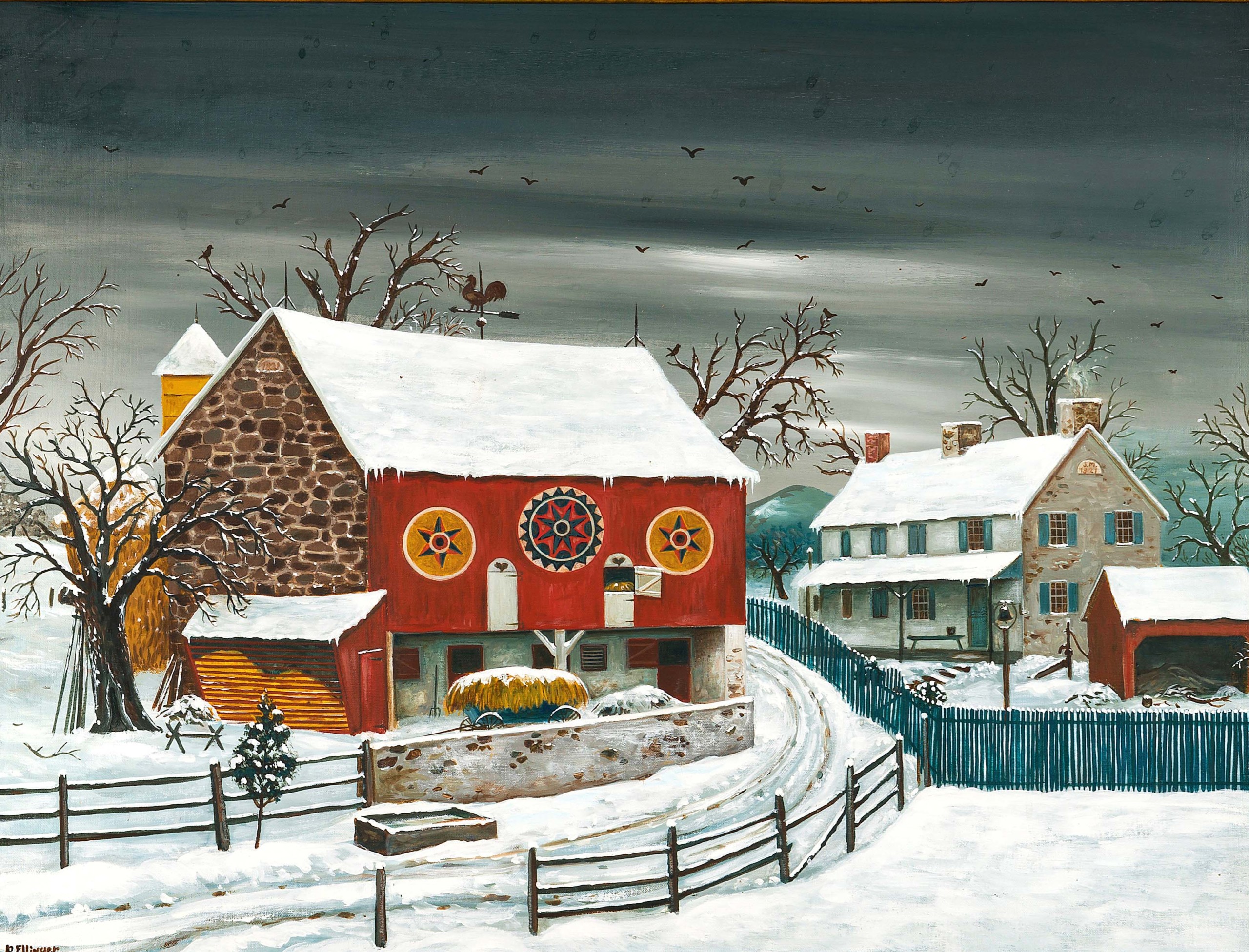
“Down Loudle Creek Way,” circa 1965, casein on canvas, 22 by 29 inches. Collection of Dr David Bronstein.
The exhibition is accompanied by a fully illustrated catalog that not only provides a comprehensive study of Ellinger’s work and art but makes a significant contribution to the understanding of Pennsylvania German folk art in the Twentieth Century. Authored by Minardi, it is self-published by Historic Trappe.
Historic Trappe is at 301 West Main Street. For information, www.historictrappe.org or 610-489-7560.

